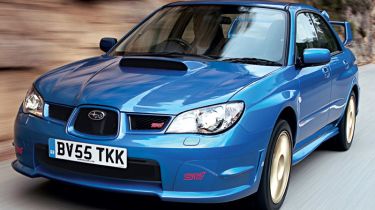Subaru Impreza
Sentimentality is not a word familiar to Subaru - particularly when it comes to design. The Impreza is on its third facelift since 2001 - a feat that takes most other firms at least 10 years to achieve
The Impreza is one of the fastest road cars money can buy, but it can't outrun time! Age is beginning to catch up with the Subaru, but the improvements of this latest facelift add extra appeal, particularly in terms of refinement and driveability. The larger engine makes a big difference, although the firm can't move quickly enough to replace some of the cabin plastics.
Sentimentality is not a word familiar to Subaru - particularly when it comes to design. The Impreza is on its third facelift since 2001 - a feat that takes most other firms at least 10 years to achieve.
But the question is, should anyone care about the new model, which arrives here later this month? Past revamps have seen revised suspension, upgraded gearboxes and even new model variants. The changes were meaningful, but not so radical as to leave the previous generation obsolete.
However, this latest version might do exactly that. Crucially, the new Impreza WRX STi is the first Subaru in the UK to sport a 2.5-litre turbocharged engine, which replaces the old 2.0-litre unit. It's also the first to carry the firm's newly designed aeroplane-style grille, and adds stylish revised headlamps and an extra wing above the rear windscreen. The changes not only promise an updated image, but a whole new driving experience, too.
One thing which hasn't changed however, is the paintwork, and our STi test model proudly sported Subaru's famous metallic blue finish. The wings are still huge, and at idle the engine note keeps a distinctive flat-four beat.
The car looks similar inside, too, with colour-coded blue Alcantara inserts on the front and rear seats to lift the appeal of an otherwise fairly drab interior. The intense red instrument display, new for this model, certainly looks busy and bright, although it can't quite disguise the fact that the dashboard plastics are starting to look dated. Happily the driving position is reasonably good, despite the fact that the steering is only adjustable for rake.
On the road, the extra capacity of the engine makes itself felt immediately. The car is more urgent low in the rev range and in-gear acceleration is much stronger. Throttle response is improved, too, and the car will sprint from 0-60mph in five seconds, going on to a top speed of 158mph.
But the biggest difference comes courtesy of a much improved torque figure - up by 49Nm to 392Nm - and revised gearing. Tuned to offer sharper acceleration at low speeds and better refinement on the motorway, it means the car feels surprisingly mature, and ultimately more capable.
Four-wheel drive continues to give the Impreza great traction. With an uprated Driver Control Centre Differential (DCCD), the car's handling is sharper than ever. The system runs automatically most of the time, splitting power evenly between the front and rear axles. However, the diff can also be adjusted manually via a switch by the handbrake, giving a rearward bias for better turn-in. The suspension is firm, but it's still supple enough to offer a comfortable ride.
There's very little body roll, and the car changes direction with virtually no loss of poise or stability. Even after a short drive, it's pretty clear the new Impreza is still a special piece of kit, and one of the most capable all-round cars in its class. However, it's under pressure like never before.
Aside from the appeal of the Mitsubishi Evo IX, there's a much improved class of hot hatches, led by the excellent VW Golf GTI, vying for the affections of driving enthusiasts. Only time will tell if the Impreza can meet their challenge.







